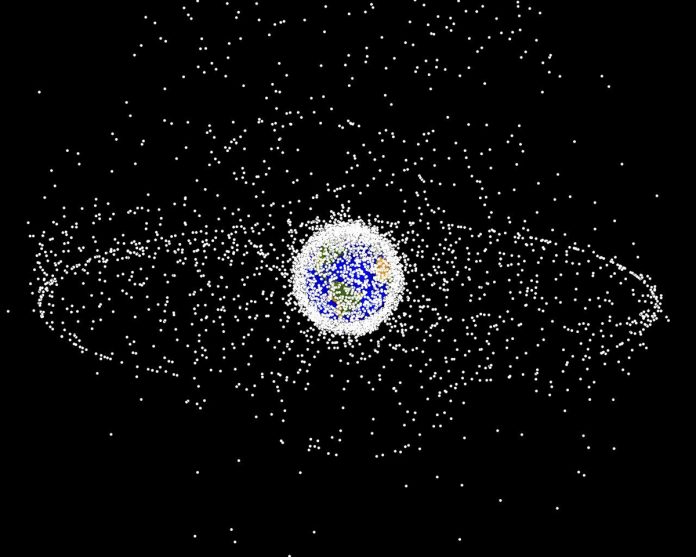The COSPAR Panel on Potentially Environmentally Detrimental Activities in Space (PEDAS) raise awareness of the human footprint on space, particularly the resulting space debris
For decades, the topic of space debris has been a niche concern. Researchers in the field were often perceived as spoilsports focussing on the ugly side of humanity’s reach beyond Earth. But 65 years of spacefaring have left marks, such that the topic of space debris nowadays can no longer be ignored.
The human footprint in space is not only a literal footprint on the Moon, but a footprint of space debris, human-made objects without a current function or the expectation of assuming or resuming a function.
A new era of spacefaring
With the CubeSat revolution, spacefaring has entered a new era of smaller cost-efficient satellites. In its wake, large sums of money have been funnelled into near-Earth spacefaring, moving away from government orders to the consumer market. The effect we are currently witnessing is the launch and operation of mega-constellations of many thousands of satellites. With the promise of cost-saving, further large constellations follow almost inevitably.
Spacefaring and the resulting space debris have long been ambivalent. There were days of competing in the space race on the one hand. On the other, there was the hope for space as an international location opening new avenues of collaboration through projects such as the International Space Station. Since the war in Ukraine, this hope has proved brittle. The recent uptick in anti-satellite action by China, Russia, and the U.S. shows how intentional destructive action has become a reality in near-Earth space again. In addition, active debris removal, as necessary as it is, is also a dual-use technology, and avenues for misuse and weaponisation are all too apparent.
Naturally, sustainability considerations are often overpowered by short-term gains. Competing interests make the governance of space all the more critical. Legal frameworks, such as the 1967 Outer Space Treaty (OST) and the 1979 Moon Agreement, are, to say the least, outdated. The NASA Artemis Accords is a step in the right direction, but also clearly caused misunderstandings in seemingly cementing U.S. dominance. And the Inter-Agency Space Debris Coordination Committee (IADC) Space Debris Mitigation guidelines, initially formulated in 2002, clarified in 2007 and modified in 2020, are not anchored in the national law of spacefaring nations.
At the same time, the problem of space debris is not limited to near-Earth space. The IADC Space Debris Mitigation guidelines list only near-Earth space up to the geosynchronous region as protected regions. However, spacefaring is pushing into the cislunar region. Planned government missions are only the first wave, closely followed by further actors populating well beyond the geosynchronous region, expanding the problems of sustainable use of space and pushing the problem of remnants of human spacefaring in orbit into this larger region.
Governance can only be successful when there is a willingness to act, namely by the nations and entities involved in spacefaring, and, equally importantly, when science and engineering provide actionable knowledge. Actionable knowledge involves accurate assessment of the current situation, and also insight into the relations of cause and effect of hypothetical actions and engineering solutions to current and future challenges.
To highlight only two of many aspects
In public discussion, the Kessler syndrome is often mentioned, a concept dating back to 1978. While this notion of cascading collisions is still very relevant, developments since then in terms of critical spatial densities have been largely ignored in popular public debate. The question is irrelevant if the Kessler syndrome “has started”, but instead, do we want to act on critical densities and are we willing to impose restrictions? It is a well-known fact that several low-Earth orbit regions are already debris-dominated. As so often in the real world, these problems are just not that simple. Densities are not a fixed value, and also depend on the actual day-to-day conduct of all contributors to space traffic, but that does not mean that density values are arbitrary.
With a higher density of objects, events with a significant probability of collision have become more frequent. Autonomous or semi-autonomous collision avoidance has taken the front seat in public debate. However, executing a collision avoidance manoeuvre is only one small part of the overall collision and collision avoidance problem. The challenge is that improved sensing capabilities are detecting smaller objects. Furthermore, more objects are being launched into orbit.
Indiscriminately acting on all objects independent of size becomes prohibitive. However, size is also not a directly accessible parameter with a single type of sensor, and hence is uncertain. To be safe, the probability of collision thresholds are of the order of 10-6. However, it is also clear that calculating the probability of collision must be improved and supplemented by other measures to remain actionable in a denser environment, while significantly decreasing computation time per potential collision event.
Acting now
No-one can afford to delay dealing with current and future space debris in the near-Earth and cislunar realm. What is at stake is nothing less than maintaining access to space.
The challenge of space debris and sustainable use of space needs the determination and cooperation of all partners. Researchers have the mandate to gain, and subsequently formulate, actionable information as clearly as possible and as differentiated as necessary. This also implies that funding is available to generate such knowledge. In the public forum, recent results must be the focus of discussions, rather than decades-old, outdated measures, with an emphasis on the current and future situation. There must be a willingness to listen and to act in governance and not let unrestrained economic interests dominate.
The COSPAR Panel on Potentially Environmentally Detrimental Activity in Space (PEDAS), in the upcoming COSPAR Scientific Assembly 16-24 July 2022, Athens, Greece, discusses the latest research results, not only on densities and collision avoidance actions, but on the influence of mega-constellations, information assessment, and space debris characterisation in general.
Please note: This is a commercial profile











